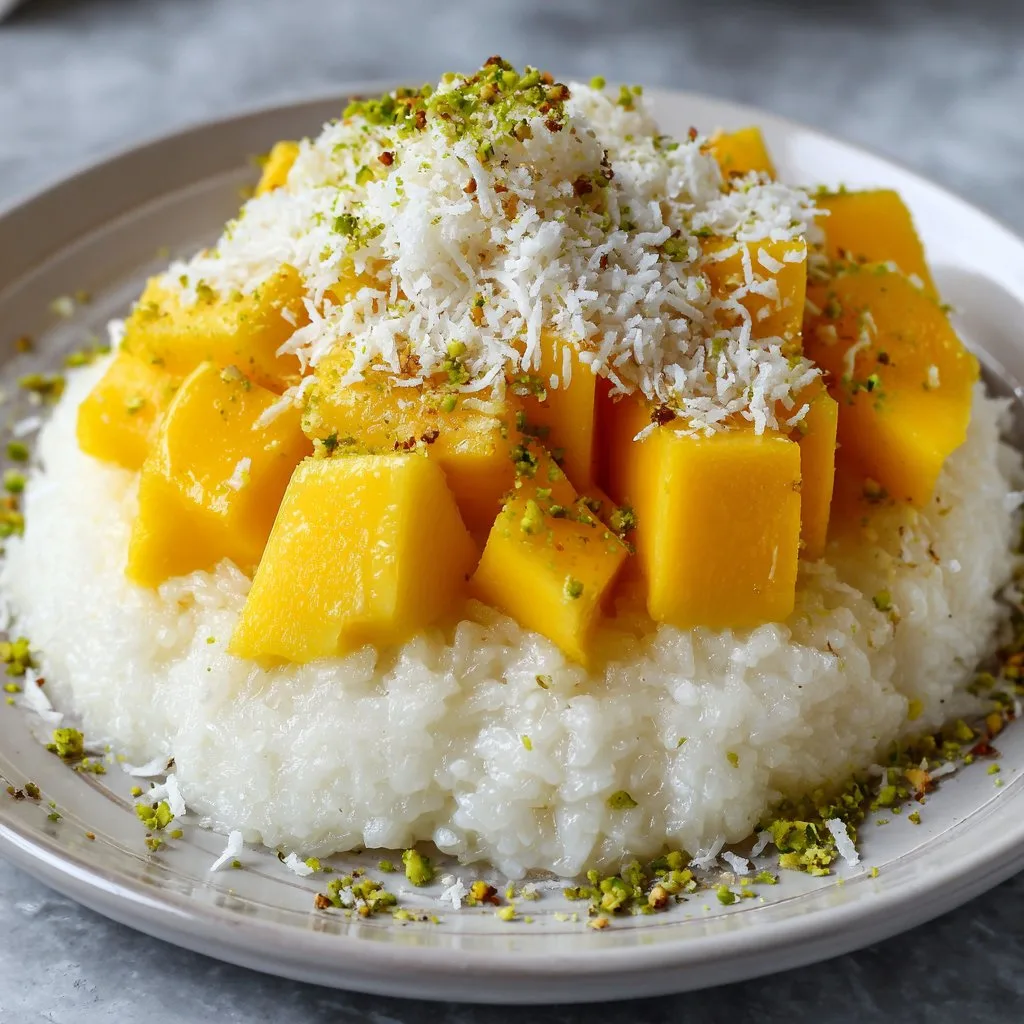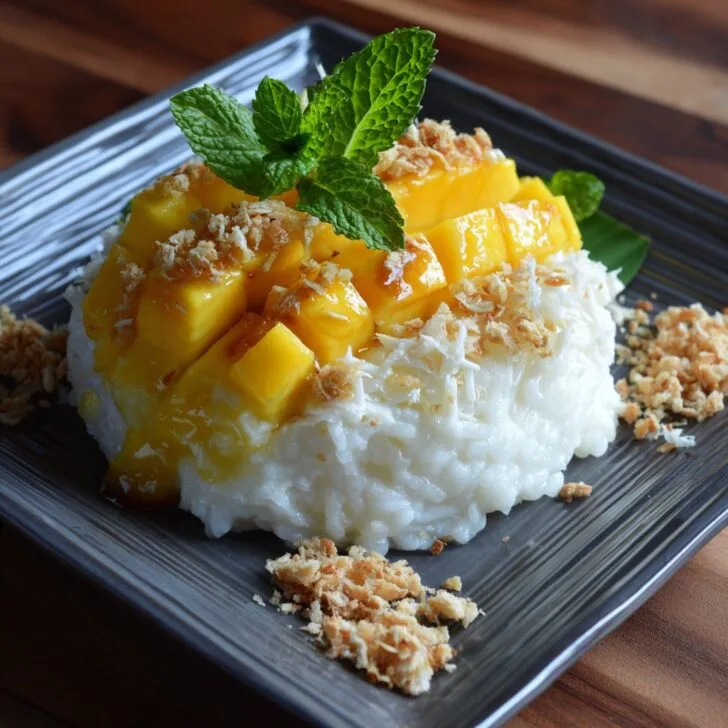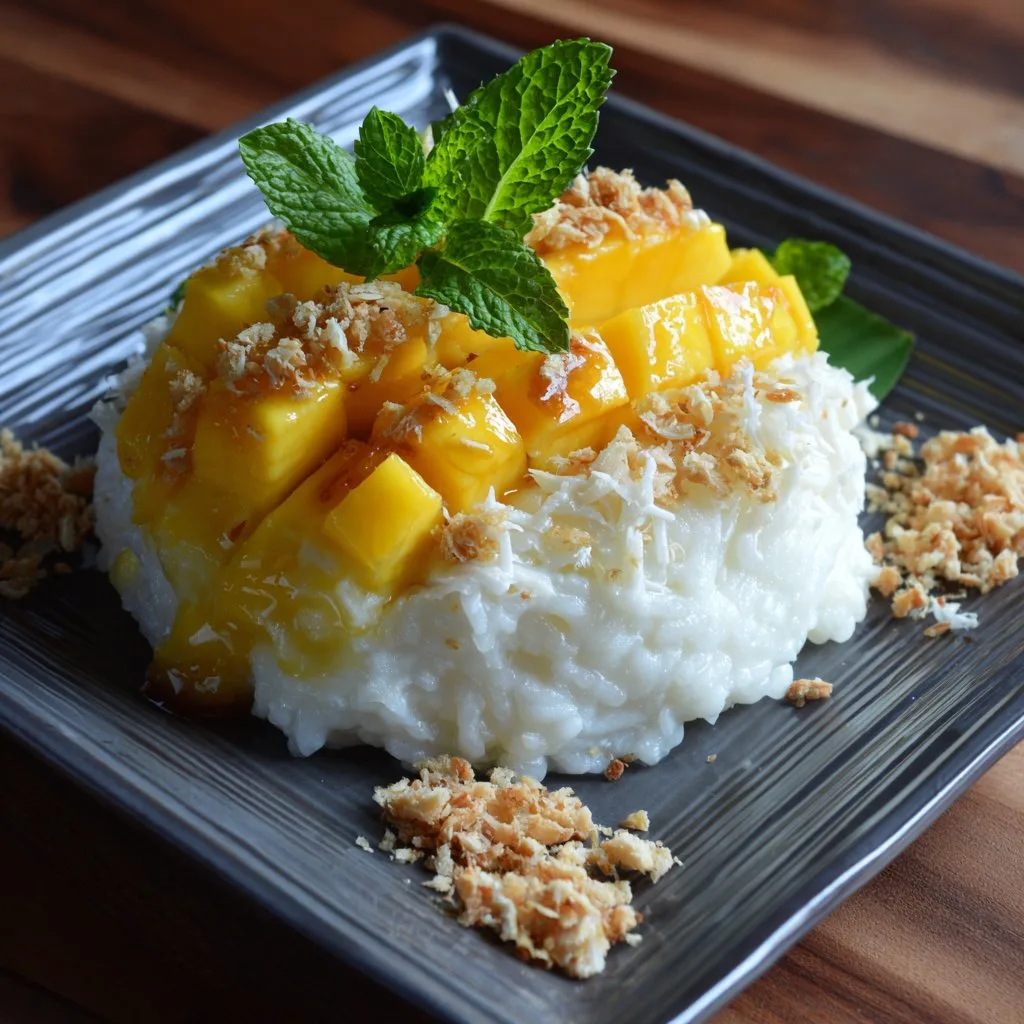Let Me Tell You About Mango Sticky Rice
If you’ve ever wandered through a night market in Thailand (or, honestly, watched too many travel food shows like I do), you know Mango Sticky Rice is just irresistible. I remember the first time I tried making it at home for my family—my kitchen smelled amazing, but I still got coconut milk everywhere (pro tip: don’t wear white, trust me). But hey, even the mess couldn’t stop us from licking the plates. It’s one of those desserts that somehow makes you feel like you’re on vacation, even if it’s just a Tuesday night.
Why I Think You’ll Love This
I make this when I want to impress guests, but mostly because my kids go bonkers for anything with ripe mangoes (they eat the fruit before I can even finish slicing it). Also, honestly, it’s just fun. Sometimes the sticky rice frustrates me—like, why does it need to be soaked so long? But I keep coming back to it. The coconut sauce is so good I could drink it straight from the saucepan (don’t judge, just try it). And when you need a taste of summer—this is it, friend.
What You’ll Need (And What You Might Sub in a Pinch)
- 1 cup glutinous (sticky) rice (I’ve used regular sushi rice when desperate—it’s not quite right, but it works)
- 1 ½ cups coconut milk (any brand is fine, but my grandma swore by Chaokoh)
- ⅓ cup sugar (white is classic, but brown sugar works if you like it a bit caramel-y)
- ¼ teaspoon salt
- 2 large ripe mangoes (Ataulfo is my go-to, but any sweet mango will do)
- 1 tablespoon toasted sesame seeds or mung beans (I sometimes skip this if I can’t be bothered to toast anything)
- Optional: pandan leaf for soaking rice (only if you want to feel extra fancy)
How I (Usually) Make Mango Sticky Rice
- Soak the rice: Rinse the sticky rice with water a few times until the water’s almost clear. Then let it soak in fresh water for at least 4 hours (overnight if you remember, which I usually don’t).
- Steam the rice: Drain it and steam it in a cheesecloth over simmering water for about 25-30 minutes. If you don’t have a steamer, use a metal sieve over a pot; just keep an eye on the water level. Rice should be glossy and, well, sticky.
- Make the coconut sauce: In a saucepan, combine 1 cup coconut milk, sugar, and salt. Stir until dissolved and just hot (don’t boil, or it’ll get weird and separate). This is where I usually sneak a taste.
- Mix the rice and coconut: Dump the hot, cooked rice into a bowl, drizzle about ¾ of your coconut sauce over it (save the rest for serving), and gently stir. Cover and let it chill out for 15-20 minutes so the rice soaks up all the flavor.
- Slice the mangoes: Peel and slice the mangoes however you like—fancy fans or lazy chunks; it’s all good.
- Serve: Scoop a pile of sticky rice onto a plate, top or side it with mango slices, pour over the rest of the coconut sauce, and sprinkle sesame seeds or mung beans on top if you’re feeling motivated. Don’t worry if it looks a bit messy; it always does in my kitchen.
Random Notes from My Kitchen
- Once, I tried skipping the rice soaking step and, well, my rice was more brick than sticky. Don’t do that.
- If you’re out of coconut milk, I tried using almond milk with a splash of coconut extract—actually, not too bad!
- I’ve noticed the mangoes taste even sweeter if you chill them before slicing, but that could just be in my head.
Things I’ve Tried (Some Worked, Some... Not So Much)
- Adding a pinch of cardamom—which was delicious, but my daughter declared it “too grown-up.”
- Using canned mangoes. Not recommended if you can get fresh; it’s just not the same. Like, not even close.
- Swapping sesame seeds for crushed peanuts once. That was... fine. Just fine.
Equipment (But You Can Improvise!)
- Steamer or bamboo basket (or, in a pinch, I once used a metal colander over a pot and while it looked ridiculous, it worked)
- Cheesecloth (or a clean kitchen towel; I’ve even used a clean pillowcase once when nothing else was clean—don’t tell my mom)
- Sharp knife for the mangoes (unless you like really rustic chunks, which honestly sometimes I do)

How to Store (Like You’ll Have Leftovers)
You can keep the rice and mango separate in airtight containers in the fridge for up to 2 days. But in my house, it never lasts more than a day! The rice will harden up, so just reheat it gently with a splash of coconut milk (or water if you’re out).
How I Serve It (And a Weird Family Tradition)
I like to serve Mango Sticky Rice slightly warm, with the mango cold—contrast is everything. For some reason, my family insists on eating it with tiny coffee spoons (don’t ask, it’s just a thing we do). A little extra coconut sauce on the side never hurts. Sometimes we even eat it for breakfast if there’s any left.
Pro Tips (Aka What I’ve Messed Up Before)
- Don’t try to rush the soaking or steaming; I did once, and the rice was crunchy. Not in a good way.
- Always taste your coconut sauce. Sometimes the coconut milk is sweeter or saltier than you expect.
- If your sauce separates, just whisk it back together over low heat (don’t panic—it happens to the best of us, or maybe just to me).
FAQ: Real Questions I’ve Gotten (And Some I’ve Asked Myself)
- Can I make Mango Sticky Rice ahead of time?
Yeah, you can, but don’t assemble it until you’re about to eat. The rice gets kind of weird if it sits too long with coconut sauce. - What if I can’t find glutinous rice?
You can try sushi rice (like I mentioned), or check out ImportFood’s sticky rice guide for alternatives. - Is this gluten-free?
Sure is, as long as you use plain glutinous rice (which has no gluten, weirdly enough). Celiac.com has good info if you’re worried about cross-contamination. - Can I use other fruits?
Of course! I once used ripe peaches when mangoes were out of season—good, but definitely not the same vibe.
Final Word (And a Slight Digression)
If you’re still reading, thanks for sticking with my rambling. I could talk about mangoes and rice all day, but I should probably go do the dishes now. Or maybe just eat another bowl. Anyway, I hope you give Mango Sticky Rice (Thai Style) a go—let me know how it turns out, and if you figure out a way to keep the coconut sauce from boiling over, please share. My kitchen counters would thank you.
Oh, and if you want to see a really cool traditional method, check out Hot Thai Kitchen’s video. Their technique is next level (mine is more kitchen-table-level, but hey, it gets the job done).
Ingredients
- 1 cup glutinous (sticky) rice
- 1 ½ cups coconut milk
- ⅓ cup granulated sugar
- ¼ teaspoon salt
- 2 ripe mangoes, peeled and sliced
- 1 tablespoon toasted sesame seeds or mung beans (optional, for garnish)
- ¼ cup coconut cream (optional, for topping)
- Water for soaking and steaming rice
Instructions
-
1Rinse the glutinous rice under cold water until the water runs clear. Soak the rice in water for at least 4 hours or overnight.
-
2Drain the soaked rice and steam it over boiling water for 25-30 minutes, or until tender and translucent.
-
3While the rice is steaming, combine coconut milk, sugar, and salt in a saucepan. Heat gently over medium heat, stirring until the sugar dissolves. Do not boil.
-
4Once the rice is cooked, transfer it to a bowl and pour in about 1 cup of the sweetened coconut milk. Mix well, cover, and let it sit for 10-15 minutes to absorb the flavors.
-
5To serve, place a portion of sticky rice on a plate, top with mango slices, and drizzle with extra coconut milk or coconut cream. Garnish with toasted sesame seeds or mung beans if desired.
Approximate Information for One Serving
Nutrition Disclaimers
Number of total servings shown is approximate. Actual number of servings will depend on your preferred portion sizes.
Nutritional values shown are general guidelines and reflect information for 1 serving using the ingredients listed, not including any optional ingredients. Actual macros may vary slightly depending on specific brands and types of ingredients used.
To determine the weight of one serving, prepare the recipe as instructed. Weigh the finished recipe, then divide the weight of the finished recipe (not including the weight of the container the food is in) by the desired number of servings. Result will be the weight of one serving.
Did you make this recipe?
Please consider Pinning it!!


